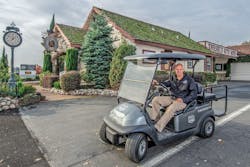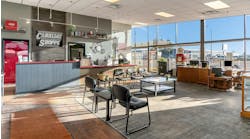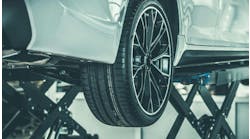Tom Kniesel, co-owner of Kniesel’s Collision Centers in California, valued the family-oriented feel of his first shop. With five locations today, Kniesel spends his days instilling that feeling at each shop and developing a systematic approach for operations.
This is a family-run business that my dad started in the 1960s. I was basically born into it. I’ve always had a passion for this industry and type of work. It’s always been my thing, and I’ve done it as long as I can remember.
I finally moved into the office when I was 30 after working 16 years as a body man. My brother and I are now the primary partners in the company. We’re complete opposites. He doesn’t like to get his hands dirty. He enjoys the public relations and marketing side of the business more than anything. So he does that while I control operational issues. The opposite skill sets complement each other pretty well, and have made for a good partnership.
We had one location when we took over as owners, but quickly realized running one shop wouldn’t be enough for the two of us. We’ve opened four additional locations over the last 10 years, two in the last year, for a total of five.
—Tom Kniesel, co-owner, Kniesel’s Collision Centers
We strive to have a family feel throughout the company. That was easy with one shop, but it became much more difficult with each new location. Naturally, it’s turned into more of a corporate business that has to be run more systematically. That’s good, but it can also detract from the original family personality. So each day I try to develop unified systems while keeping a personal culture. It’s not easy.
I really don’t have a set plan or routine for each work day. I operate on the fly. I don’t even have an office or workspace at any of our locations. I think that’s great; it allows for flexibility each day.
I don’t have to be anywhere early in the morning. The shops are able to get going on their own. It’s generally not necessary to be anywhere until around 9 a.m.
I’ve been spending more time than usual at our newest location trying to get that off the ground. With new locations, there seems to be a lot of issues that arise and questions to answer, especially with new employees and daily operations. Getting things up to speed takes time. I spend about four hours a day at that location building operations—training employees, implementing systems and programs, and obtaining insurance contracts. I want to make sure everyone is on the same page with how we want things done.
Still, my day’s plans change when I wake up. It just depends on what happens and where I’m needed the most. Wherever I end up, my focus is the same. I try to unify processes across the company and maintain a personal connection with every employee.
I start with a walk-through of the shop floor to assess quality and procedures. I’ve realized the importance of standardizing and unifying procedures. It’s especially important with multiple locations in order to monitor and compare each shop’s performance consistently. It’s impossible to do that if they all operate differently.
During the walk-through, I try to develop concepts for written SOPs for everything we do. I constantly try to simplify and unify the company. SOPs are the biggest thing I’ve been working on lately because they require careful thought and employee feedback.
I do miss being a technician. That’s why I love overseeing the operational side of things. I stay hands-on with technical issues and training along with the other guys in the shop. I still go to all the training with our technicians. I’ve been to most of the training courses available—I-CAR and several OEM trainings.
That allows me to stay up on quality control issues throughout our repair processes, and to offer training and feedback to technicians within any particular department. I enjoy that part of my job. It keeps me in tune with the work technicians produce each day.
I’m not a distant and detached owner. I’m personable with all employees because I want them to feel comfortable with me. I stay close with them and interact as much as possible. We don’t just talk shop, either. I ask them about their lives and families to establish a deeper relationship.
To help foster that connection, we have standardized a consistent strategy for employee promotions, growth and performance reviews. That gives me a way to constantly remind employees that they have something to work toward, and have a future with the company.
I’m close with most of the employees. They all have my personal cell phone number and call me with questions. I’m glad they regularly call because it shows they’re comfortable interacting directly with the owner, which I believe is a valuable component of having a personal touch within the business. That relationship improves employee buy-in to the business, which improves productivity. There’s no process to automate that. It’s a responsibility that I carry every day.
Of course, nurturing those relationships is difficult with several employees. It was much easier when we were small, but finding time to interact with people across five shops is tough. I’ve learned that I need to rely on our managers to continuously replicate company values.
I also make time in the workday for direct customer interaction. There’s a portion of our customers who have grown to be friends over the years. Some of them prefer to deal directly with me after a wreck. They have my cell number and call me directly.
Although I’m busy, giving that personal attention is important. So I run over to certain shop locations when those situations arise to greet them when they arrive. Just a few minutes of in-person communication seems to improve satisfaction scores and repeat business. It keeps those relationships going and keeps them coming back.
If everything is running smoothly at one shop location, I’ll head to another location. Then I do the same things—walk through the shop, assess processes and cultivate relationships.
With all that running around, I can’t be everywhere at all times. I’ve had to empower my managers with a lot of decision-making abilities as a result. I put solid managers in place who are capable of making decisions the same way I would. That seems to be the biggest thing with learning to operate an MSO.
The managers are able to handle most daily things on their own. They know our policies and have the power to do whatever they need to do, including hiring, firing and experimenting with new ideas. They don’t need permission for many things. I let them do what they need to do and only offer assistance when they ask for it.
I try to end my days as early as possible, usually around 3 p.m. or 4 p.m. If everyone is doing their job, which is the whole idea of standardizing processes, there isn’t any reason for me to be there all day long. I try not to do any work from home, either. That time is reserved for my daughter.
Each day’s work can be stressful, but I try not to carry that stress around. I try to be easy-going and deal with situations the best I can at the moment. All you can do is make the most out of each situation and move on. I’ve learned that dwelling on things that went wrong doesn’t do any good. It’s just nonproductive time. That’s why I love my daily focus—how to make everything better.



